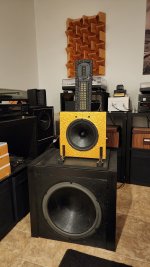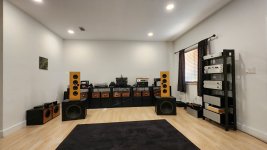Later i built second, even more compact version of the 4way open baffle setup. Bass is dipole with two 15" woofers in tandem. Rest is the same, as is crossover. I have posted these before, just to show small or no baffle.
I use biamping with plate amp active plus 31band ultracurve, so making bass flat is no issue.
I use biamping with plate amp active plus 31band ultracurve, so making bass flat is no issue.
Attachments
OK, here's the same setup as modeled in Edge above (see post #4657). This time, in Basta!, using driver parameters, and with a passive crossover. @adason I adjusted the vertical scale to approx 25dB/decade, in line with IEC recommendations. (I may have made the baffle slightly wider this time, bringing the problem frequency a touch lower.)

Dipole cancellation is compensated in active crossover by selecting different crossover frequency for upper and lower path. Say your upper path is 180 Hz (i use 150Hz), but for low path you select 100, or lower, even 80 Hz. Then you simply increase the level in lower path to compensate. Decreasing dipole cancellation is opposite to eq, thus helping to flatten it out. To some extent, offcourse. Nothing is perfect.
I don't document everything I do. I have build many test baffles an measured and listend to them. For one baffle I take about a hundred measurements, most of them are thrown away instantly. I'm not a bookkeeper, I just build loudspeakers but I do remember mistakes.Please post the measurements. Or link to thread where you provided data.
My mostly folded front open baffle speakers. The stereo pair started out as 12" single drivers, placed for easy active eq to flatten a little but mostly suit my taste. Soon after adding helper tweeter attempts, I went full multiway, with placement and crossover points chosen for low excursion and peaks if they weren't dipped with.the crossover.
I didn't at first use a rear tweeter, but it's paralleled with the front one to share the load, which allows a strain free sounding lower output to meet the mid at-6db at 1800 hz first order.
The old Sansui 12" have new lighter surrounds, which further lower their made for sealed cabinets Q.
I'd tried these with a couple kinds of 2nd order filters with closer filter knees, but like the sound and lower parts count of a first order crossover, ranging between -5 and -9db crossover points.
I do use a bass panel for movies and cable programming, but there's enough to not use feel like I need it for my 2 channel system for music streaming, or records.


I didn't at first use a rear tweeter, but it's paralleled with the front one to share the load, which allows a strain free sounding lower output to meet the mid at-6db at 1800 hz first order.
The old Sansui 12" have new lighter surrounds, which further lower their made for sealed cabinets Q.
I'd tried these with a couple kinds of 2nd order filters with closer filter knees, but like the sound and lower parts count of a first order crossover, ranging between -5 and -9db crossover points.
I do use a bass panel for movies and cable programming, but there's enough to not use feel like I need it for my 2 channel system for music streaming, or records.
OK, here's the same setup as modeled in Edge above (see post #4657). This time, in Basta!, using driver parameters, and with a passive crossover. @adason I adjusted the vertical scale to approx 25dB/decade, in line with IEC recommendations. (I may have made the baffle slightly wider this time, bringing the problem frequency a touch lower.)
View attachment 1457492
@ianbo What did the crossover look like used in this simulation? 🙂
I do not have much update, except i change top open baffles from time to time, just to make things interesting. Tops are four 4" reference series aluminum cone daytons. In 2.5 way configuration, plus dayton amt tweeter. Amazing coherency, great soundstage.
Plus i partly organized my amps and preamps/crossovers on the rack right.
Plus i partly organized my amps and preamps/crossovers on the rack right.
Attachments
- Home
- Loudspeakers
- Multi-Way
- Ultimate Open Baffle Gallery

